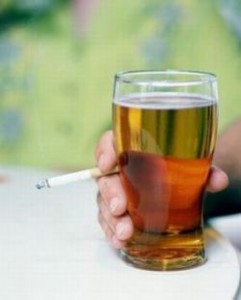Anyone who has gone to parties and social gatherings will be aware of people who smoke only socially. Social smoking or smoking only atparties seems like a concept that is generally accepted by many. Research supports the fact that those who consume large amounts of alcohol are also likely to be those who smoke a lot too. It is probably not known that the combined effects of alcohol and tobacco can be relatively more devastating.
Almost all alcoholics (80 to 95 percent) smoke cigarettes. This is a rate that is three times higher than the normal population. Out of this about 70 percent of alcoholics are known to be heavy smokers as well. The proportion of heavy smokers in the overall population is ten percent.

The concurrent use of alcohol and tobacco fall under what is called the rewarding affect or the aversive affect. In the first case consumption of the other adds to the rewarding effect of the first and in the aversive effect the negative effect of the first reduces.
The Risks Associated with Consuming Alcohol and Smoking
Smoking and consuming alcohol increase the risk of cardiovascular andlung diseases. The combined effect has also been known to cause somekind of cancers like mouth cancer, throat cancer and esophagus cancer. The risks posed are greater than the additive of the risks associated with smoking tobacco and drinking alcohol. The risk of developing a mouth cancer is 7 times higher among those who smoke and 6 times higher for those who consume alcohol than the general population. The same risk is amplified to 38 times
buy tadalafil online more for those who smoke and consume alcohol at the same time. And for an
alcohol test to work, you must put down your cigarette – 15 minutes should go by before you consume anything for the test to be administered correctly.
Tobacco and alcohol together also result in nutritional deficiencies too. This occurs due to the lack of proper absorption of the food. The combination is also notorious for resisting the proper action of antioxidants, elements that are able to otherwise fight cancer cells from developing.
How does Simultaneous Tobacco and Alcohol Use Increase the Risk of Cancer?
There are more than 4000 toxic chemicals in a cigarette that are burnt when one is smoked. These are collectively known as tar and are converted into chemicals that can cause cancer (carcinogens). When one consumes alcohol, certain microsomal enzymes are produced that can increase the activity of these toxic chemicals, increasing the chances of smoking related cancers to a large extent. Some researchers also feel that the dehydrating effect of alcohol results in the ability of the tobacco chemicals to be absorbed in the mouth to a larger extent. This results in a much higher risk of mouth cancer than otherwise. Whether it is to show off to the opposite sex or generally increase camaraderie among friends, social smoking is something that should be avoided completely, lest it become a habit to smoke every time you drink. If you understand the amount of amplification that smoking and drinking together brings about, you should surely ensure that you avoid concurrent consumption.